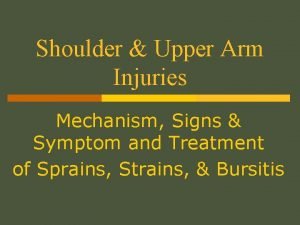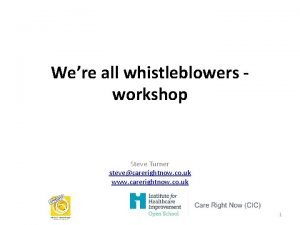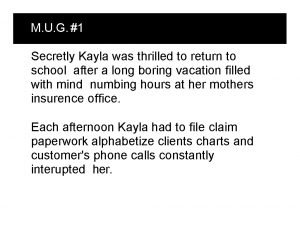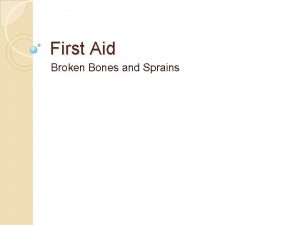Sprains Kayla Smith Kayla Sigmon What is a







- Slides: 7

Sprains Kayla Smith & Kayla Sigmon

What is a sprain? Wrench or twist the ligaments of (an ankle, wrist, or other joint) violently so as to cause pain and swelling but not dislocation. A sprain is an injury to the ligaments around a joint. Ligaments are strong, flexible fibers that hold bones together. When a ligament is stretched too far or tears, the joint will become painful and swell.

Symptoms: Joint pain or muscle pain Swelling Joint stiffness Discoloration of the skin, especially bruising.

Sprain types: Grade 1: Minimal tenderness and swelling. Grade 2: Moderated tenderness and swelling, decreased range of motion, and possible instability. Grade 3: Significate swelling and tenderness, and instability.

How to treat a sprain? Apply ice right away to reduce swelling. Wrap the ice in cloth. Do not place ice directly on the skin. Wrap a bandage around the affected area to limit movement. Wrap firmly, but not tightly. Use a splint if needed. Keep the swollen joint raised above your heart, even while sleeping. Rest the affected joint for several days. Aspirin, ibuprofen, or other pain relievers can help. DO NOT give aspirin to children. Keep pressure off the injured area until the pain goes away. Most of the time, a mild sprain will heal in 7 -10 days. It may take several weeks for pain to go away after a bad sprain. Your health care provider may recommend crutches. Physical therapy can help you regain motion and strength of the injured area.

When to contact a Medical Professional: Go to the hospital right away or call 911 if: You think you have a broken bone. The joint appears out of position. You have a serious injury or severe pain. You hear a popping sound and have immediate problems using the joint. Call your health care provider if: Swelling does not start to go away within 2 days. You have symptoms of infection, including red, warm, painful skin or a fever over 100°F. The pain does not go away after several weeks

Prevention: Wear protective footwear during activities that place stress on your ankle and other joints. Make sure that shoes fit your feet properly. Avoid high-heeled shoes. Always warm-up and stretch before doing exercise and sports. Avoid sports and activities for which you have not trained.













